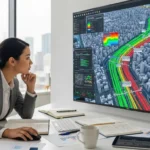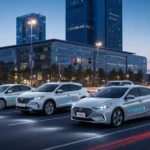Hyperloop technology, a concept that once existed solely in science fiction, is now becoming a reality. This groundbreaking transportation system promises to redefine high-speed travel and offer the potential to revolutionize how we move people and goods. In this comprehensive article, we will explore the world of Hyperloop technology, delving into its fundamental principles and technology, discussing its potential to transform transportation, and highlighting the challenges and opportunities.
What is Hyperloop Technology?
Hyperloop technology is an innovative mode of high-speed transportation characterized by a system of vacuum tubes or low-pressure tunnels through which passenger or cargo pods travel at extremely high speeds. Elon Musk first introduced the concept in a 2013 white paper, and it has since garnered significant attention and development efforts from various organizations and researchers worldwide.
How Does Hyperloop Technology Work?
Hyperloop technology operates on a combination of magnetic levitation (maglev) and reduced air pressure. The passenger or cargo ponds, commonly called “capsules,” travel through low-pressure tubes or tunnels. Magnetic levitation technology lifts the capsules off the ground within the tubes, significantly reducing friction and allowing them to glide smoothly. Moreover, the near-vacuum environment inside the tubes minimizes air resistance, enabling the capsules to reach unprecedented speeds.
Advantages of Hyperloop Technology
Hyperloop technology offers several compelling advantages over conventional modes of transportation.
Unprecedented Speed
Hyperloop systems have the potential to achieve incredibly high speeds, potentially exceeding 700 miles per hour (1,100 kilometers per hour). This could reduce travel times significantly compared to traditional modes of transportation. For instance, a journey that would take hours or even days by car or train could be completed in minutes using Hyperloop technology, making long-distance travel more accessible and efficient.
Energy Efficiency
Hyperloop systems are highly energy-efficient due to their low air resistance and minimal friction. This efficiency translates into reduced operational costs and a smaller environmental footprint. By minimizing energy consumption, Hyperloop technology contributes to sustainability efforts and helps reduce transportation’s overall carbon footprint.
Reduced Congestion
Hyperloop systems can help alleviate traffic congestion in densely populated areas, providing a fast and efficient alternative to conventional commuting. As urbanization continues to increase, easing traffic congestion becomes a critical priority. Hyperloop technology offers a solution by enabling faster, more reliable transportation, reducing the strain on existing infrastructure, and improving urban residents’ overall quality of life.
Minimal Environmental Impact
Hyperloop technology produces minimal emissions and noise pollution, making it an environmentally friendly mode of transportation. By relying on electric propulsion and operating within low-pressure environments, Hyperloop systems reduce the release of pollutants and minimize disruptions to natural habitats and urban environments. This environmentally conscious approach aligns with global efforts to combat climate change and promote sustainability.
Applications of Hyperloop Technology
Hyperloop technology has the potential to transform transportation across various sectors and industries.
Interurban Travel
Hyperloop systems can connect cities and regions, offering rapid and convenient interurban travel. This could revolutionize commuting, making long-distance travel more accessible and efficient. Imagine living in one city and working in another, with a daily commute that takes minutes, all thanks to Hyperloop technology. Such connections can stimulate economic growth and expand opportunities for individuals and businesses.
Freight Transportation
Hyperloop systems can enhance freight transportation by providing high-speed cargo delivery. The ability to move goods quickly and efficiently can benefit logistics, manufacturing, and e-commerce industries. Due to congestion and logistical challenges, traditional cargo transportation often faces delays and inefficiencies. Hyperloop technology offers a solution by streamlining the movement of goods, reducing delivery times, and improving supply chain efficiency.
Urban Transportation
Hyperloop systems can be integrated into urban transportation networks, reducing congestion and pollution in densely populated areas. This can improve the overall quality of life for urban residents by offering a fast, reliable, and environmentally friendly alternative to traditional forms of transit. As cities grow and face increasing transportation demands, Hyperloop technology can help address urban mobility challenges, reducing the strain on existing infrastructure and enhancing urban sustainability.
Challenges and Future Directions
While Hyperloop technology holds immense promise, it also faces challenges that must be addressed for its widespread adoption and continued success.
Safety and Reliability
Ensuring the safety and reliability of Hyperloop systems is paramount. Comprehensive testing and certification processes are essential to gain public trust and regulatory approval. Safety protocols must be rigorously developed and implemented to mitigate risks associated with high-speed travel and complex infrastructure.
Infrastructure Development
Building Hyperloop infrastructure, including constructing vacuum tubes or low-pressure tunnels, is complex and costly. Funding and investment are critical to overcome this initial cost barrier. Governments, private investors, and international collaborations can be vital in securing the necessary resources for maglev projects. Additionally, engineering challenges related to maintaining the vacuum environment, constructing stable structures, and mitigating potential risks must be addressed during development.
Regulatory Framework
Developing a regulatory framework to govern Hyperloop technology is complex. Collaboration between governments, regulatory agencies, and the private sector is essential to establish safety standards and operational guidelines. A clear and consistent regulatory framework will facilitate the safe deployment of Hyperloop systems and ensure compliance with international safety standards.
Public Acceptance
Gaining public acceptance and trust is crucial for the success of Hyperloop technology. Outreach and education efforts can address concerns and build support for this innovative transportation system. Public engagement, information campaigns, and collaboration with local communities are essential to foster a positive perception of Hyperloop technology and gain public support for its implementation.
Conclusion
Hyperloop technology represents a transformative leap forward in the world of transportation. With the potential to offer unprecedented speed, efficiency, and sustainability, it has the power to reshape how we move people and goods. As we tackle the challenges and continue to innovate in this field, Hyperloop technology may soon become an integral part of our transportation landscape, paving the way for a more connected, efficient, and sustainable future. The ongoing development and deployment of Hyperloop systems have the potential to redefine the concept of high-speed travel and usher in a new era of transportation innovation.





